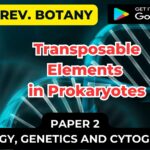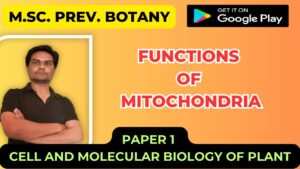Transposable elements in prokaryotes and eukaryotes
Definition of Transposons:
- Presence of transposable elements was first predicted by Barbara McClintock in maize (corn) in late 1940s.
- After several careful studies, she found that certain genetic elements were moving from one site to an entirely different site in the chromosome.
- She called this phenomenon of changing sites of genetic elements as transposition and those genetic elements were called by her as controlling elements.
- These controlling elements were later on called as transposable elements by Alexander Brink. In late 1960s this phenomenon was also discovered in bacteria.
- Consequently, the molecular biologists called them as Transposons.
- A transposon may be defined as: “a DNA sequence that is able to move or insert itself at a new location in the genome.”
- The phenomenon of movement of a transposon to a new site in the genome is referred to as transposition.
- Transposons are found to encode a special protein named as transposase which catalyses the process of transposition.
- Transposons are particular to different groups of organisms.
- They constitute a fairly accountable fraction of genome of organisms like fungi, bacteria, plants, animals and humans.
- Transposons have had a major impact on changing or altering the genetic composition of organisms.
- Transposons or transposable genetic elements are often referred to as ‘mobile genetic elements’ also.
- They can be categorized on different bases like their mode of transposition or on the basis of the organisms in which they are present.
Types of Transposons:
- Different transposons may change their sites by following different transposition mechanisms.
- On the basis of their transposition mechanism, transposons may be categorized into following types:
(i) Cut-and-Paste Transposons:
They transpose by excision (cutting) of the transposable sequence from one position in the genome and its insertion (pasting) to another position within the genome (Fig. 1).

The cut-and-paste transposition involves two transposase subunits. Each transposase submit binds to the specific sequences at the two ends of transposon. These subunits of transposase protein then come together and lead to the excision of transposon.

This excised ‘transposon-Transposase Complex’ then gets integrated to the target recipient site. In this manner, the transposon is cut from one site and then pasted on other site by a mechanism mediated by transposase protein (Fig. 2).
Examples of cut-and-paste type of transposons are IS-elements, P-elements in maize, hobo-elements in Drosophila etc.
(ii) Replicative Transposons:
- They transpose by a mechanism which involves replication of transposable sequence and this copy of DNA, so formed, is inserted into the target site while the donor site remains unchanged.
- Thus, in this type of transposition, there is a gain of one copy of transposon and both-the donor and the recipient DNA molecule are having one-one transposable sequence each, after transposition.

Tn3-elements found in bacteria are good examples of such type of transposons.
(iii) Retro Elements:
- Their transposition is accomplished through a process which involves the synthesis of DNA by reverse transcription (i.e. RNA DNA) by using elements RNA as the template.
- This type of transposition involves an RNA intermediate, the transposable DNA is transcribed to produce an RNA molecule.
- This RNA is then used as a template for producing a complementary DNA by the activity of enzyme reverse transcriptase.
- This single stranded DNA copy so formed, is then made double stranded and then inserted into the target DNA site.
- The transposable elements which require reverse transcriptase tor their movement are called retro transposons.

The Retro elements may be viral or non-viral. Out of these two, the non-viral retro elements are important and may further be classified as:
Retrovirus like elements:
- They carry long terminal repeats (LTR). Examples are copia, gypsy elements in Drosophila.
Retroposons:
- LTR are absent. Examples are LINEs and SINEs in humans.













